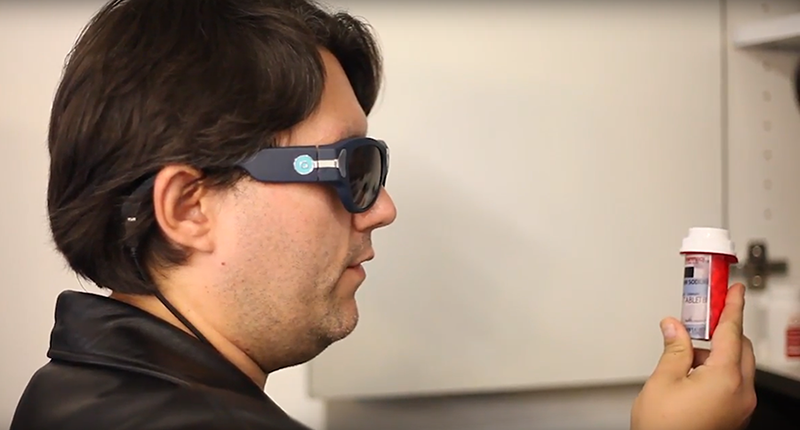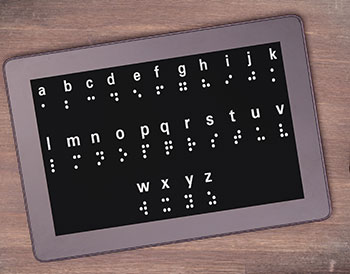Enhance Accessibility with Braille Displays and Notetakers
Enhance Accessibility with Braille Displays and Notetakers
Blog Article
Discover Innovative Devices Designed for the Visually Damaged
The development of innovative devices for the visually impaired stands for a substantial advancement in availability and independence. Technologies such as wise glasses with AI capacities and mobile applications designed to offer acoustic summaries are improving day-to-day experiences for users. In addition, wearable tools that utilize haptic responses improve ecological awareness, while contemporary Braille developments supply brand-new means to engage with text. As these tools continue to develop, their influence on the lives of those with aesthetic impairments elevates important concerns about the future of inclusivity and freedom in numerous facets of life. What lies in advance in this technical landscape?
Smart Glasses for Navigating

Smart glasses created for navigating are changing the means visually damaged people interact with their environment. These innovative gadgets use a combination of camera modern technology, expert system, and acoustic feedback to offer real-time information about surroundings. By utilizing obstacle discovery systems, smart glasses can alert users to possible dangers, allowing safer mobility in both strange and familiar settings.
The integration of GPS technology better improves navigating capacities, allowing users to get acoustic directions as they move. This hands-free technique not only promotes self-reliance yet also empowers aesthetically damaged individuals to browse city landscapes with boosted confidence. In addition, many clever glasses are furnished with functions that determine spots and street indicators, offering contextual information that enhances the user experience.
Moreover, the advancement of these devices is constantly advancing, with business working to boost the precision of things acknowledgment and broaden the series of navigational attributes. As wise glasses end up being more accessible and affordable, they hold the potential to considerably transform day-to-day life for visually impaired individuals. Ultimately, these ingenious devices represent an essential action toward inclusivity, offering enhanced flexibility and a better sense of autonomy for individuals browsing the world around them.

Mobile Application for Daily Living
Exactly how can mobile applications boost the day-to-day lives of visually impaired people? Mobile apps are reinventing the way visually damaged users navigate their atmospheres, take care of day-to-day tasks, and gain access to info. These applications supply necessary assistance through numerous functionalities, fostering freedom and boosting lifestyle.
Numerous innovative mobile applications are developed specifically for daily living. For instance, applications like Be My Eyes connect aesthetically damaged customers with sighted volunteers through video phone calls, enabling them to receive real-time assistance with jobs such as reviewing tags or navigating unfamiliar rooms. In A Similar Way, Seeing AI, established by Microsoft, makes use of expert system to describe environments, read text, and determine items, effectively changing a smart device right into a powerful tool for everyday aid.
In addition, navigation applications tailored for the aesthetically impaired, such as Aira and BlindSquare, supply audio-based directions and environmental details, allowing users to traverse their surroundings safely and with confidence. Beyond navigating and immediate assistance, mobile apps also sustain organization and job management, with functions that aid users establish pointers, develop to-do listings, and track consultations. In summary, mobile applications function as essential resources, empowering aesthetically damaged individuals to lead even more independent and meeting lives.
Wearable Technologies for Aid
Empowerment via technology is progressively apparent in the realm of wearable gadgets developed to help visually impaired individuals. These ingenious devices incorporate seamlessly into life, improving navigating and supplying necessary feedback to users. Smart glasses outfitted with cams can identify faces and review message out loud, enabling users to interact even more with confidence in social and expert setups.
One more noteworthy advancement is making use of haptic feedback systems in wearable devices. These systems make use of resonances or various other tactile signals to share info regarding the customer's environment, such as obstacles or changes in terrain, enhancing movement and security. Wearable technologies additionally include wristbands that attach to smartphones, alerting individuals to notifications through refined vibrations, therefore boosting connection without dependence on aesthetic cues.
As these modern technologies continue to develop, they are not only boosting freedom for visually damaged individuals yet also cultivating a higher sense of incorporation in society. By linking the gap in between challenges encountered in day-to-day living and the potential for freedom, wearable innovations work as essential tools in the quest for equal rights and empowerment for those with visual problems.
Audio Summary Tools
Audio summary devices play an essential duty in improving ease of access for aesthetically damaged people, supplying them with the ability to involve with aesthetic media. Voice-activated assistive devices. These devices provide narrated summaries of key aesthetic elements in films, television programs, and live efficiencies, ensuring that customers can fully understand the context and emotions communicated with visuals
Sound summary can be incorporated right into numerous systems, including streaming services, cinema screenings, and live theater. Numerous prominent streaming solutions currently consist of audio summary as an access attribute, enabling customers to pick it easily. Along with mainstream media, specialized apps also exist, providing audio descriptions for art exhibitions, museums, and various other cultural events.
The effectiveness look at this web-site of audio description hinges on the skill of the storytellers, that have to convey visual details succinctly without interfering with the initial audio. Innovations in this area are likewise leading the way for even more personalized experiences, where customers can change the level of detail and pacing according to their preferences.
Braille Innovations and Tools
Braille devices and developments have substantially changed the means aesthetically damaged individuals interact with text and information. Modern improvements have actually led to the advancement of versatile devices that enhance proficiency and freedom amongst customers.
Furthermore, portable Braille notetakers incorporate conventional Braille input with modern capabilities, promoting note-taking, organizing, and paper modifying on the move. Wearable technology for low vision. These compact tools usually include text-to-speech abilities, bridging the gap in between Braille and auditory information
On top of that, innovative Braille printers have arised, look at this website enabling customers to produce Braille tags, files, and educational products effectively. This availability fosters better participation in specialist and educational atmospheres, eventually advertising inclusivity.
Moreover, research into clever Braille modern technologies proceeds to expand. Devices that include synthetic intelligence are being explored to give real-time navigating aid and contextual info, enhancing the customer experience in diverse setups. In general, these technologies show a dedication to encouraging aesthetically damaged people through modern technology, guaranteeing they can easily access and involve with the world around them.

Conclusion
The improvement of ingenious devices for the visually damaged substantially improves self-reliance and top quality of life. These modern technologies not just foster higher incorporation however likewise promote autonomy in day-to-day activities, inevitably adding to a much more available and equitable culture for visually damaged people.
As wise glasses become more budget friendly and easily accessible, they hold the possible to dramatically transform day-to-day life for aesthetically impaired customers. Mobile apps are revolutionizing the means visually impaired customers browse their environments, handle everyday jobs, and access info. Apps like Be My Eyes attach visually damaged individuals with sighted volunteers via video clip calls, permitting them to receive real-time assistance with jobs such as reading tags or navigating strange spaces.In addition, navigation applications tailored for the visually damaged, such as Aira and BlindSquare, provide audio-based directions and ecological information, making it possible for users to traverse their environments securely and confidently.The innovation of innovative devices for the visually impaired Resources dramatically enhances freedom and quality of life.
Report this page